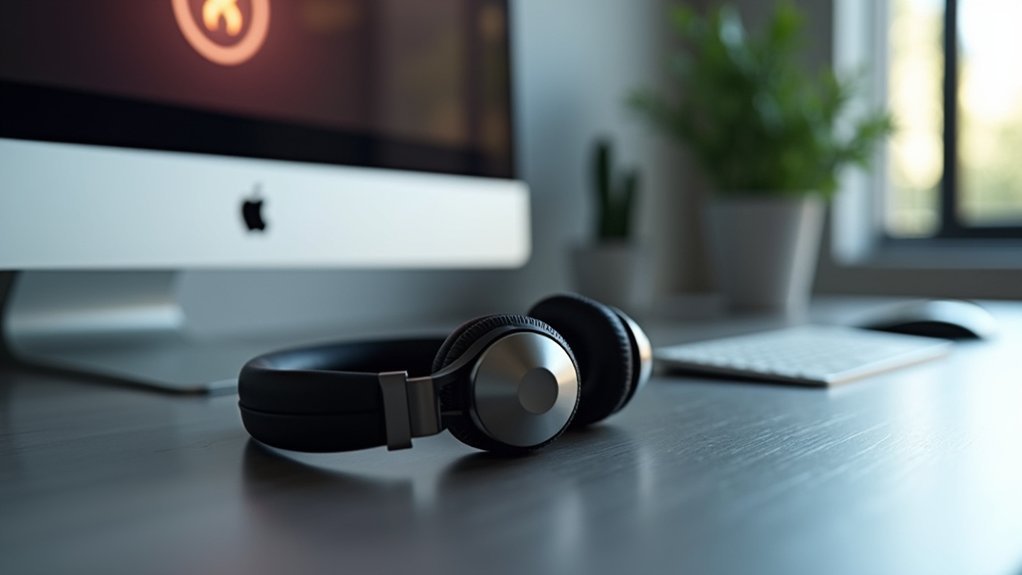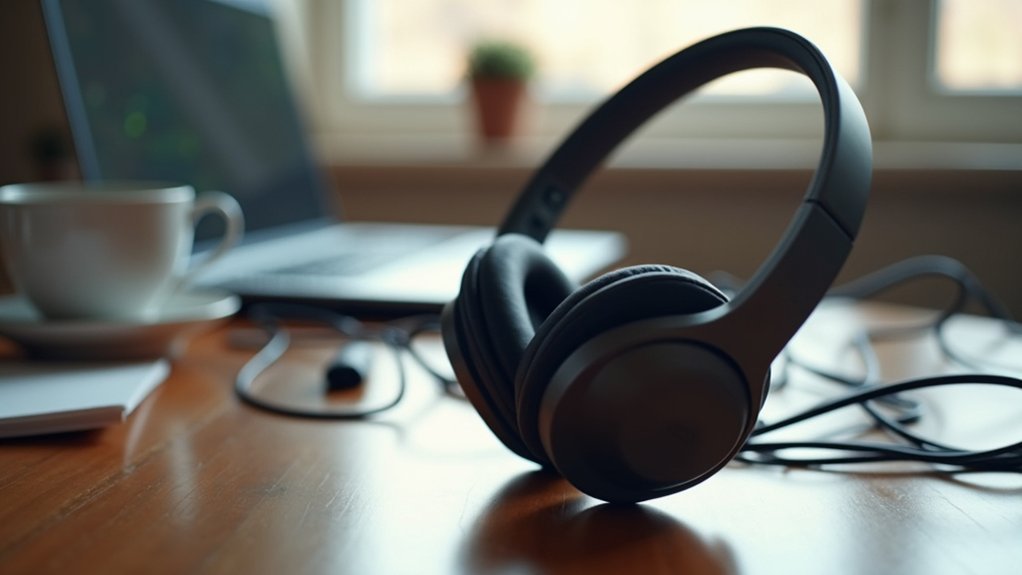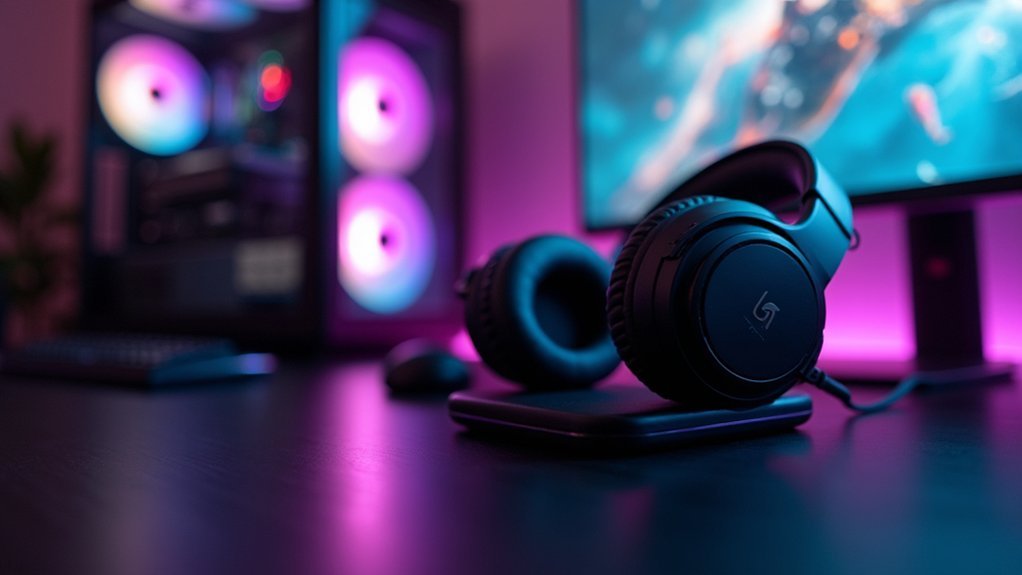You have two main wireless solutions for connecting headsets to your PC: Bluetooth technology and USB wireless dongles. Bluetooth V5.2 offers superior audio quality with up to 33 feet of range, while USB dongles provide plug-and-play convenience without requiring additional software installation. Both solutions support advanced audio codecs and offer minimal latency, making them ideal for gaming and multimedia applications. The setup process involves enabling Bluetooth or simply plugging in the dongle, then configuring your audio settings to optimize performance and explore advanced features.
Understanding Bluetooth Technology for PC Audio Connectivity

While traditional wired headsets require you to stay tethered to your desk, Bluetooth technology transforms your PC audio experience by creating a wireless connection that spans up to 33 feet. Your wireless headset connects seamlessly through Bluetooth V5.2, delivering superior audio quality with reduced latency compared to earlier versions.
You’ll need compatible drivers and proper settings to guarantee smooth connectivity between your PC and headset.
Modern Bluetooth headsets feature built-in microphones, often with noise-canceling microphone technology for crystal clear audio during calls and virtual meetings. Most models offer impressive battery life ranging from 30 to 50 hours, eliminating frequent charging concerns.
Today’s Bluetooth headsets deliver exceptional call clarity through noise-canceling microphones and extended 30-50 hour battery performance.
Unlike USB connections, Bluetooth provides true wireless freedom while maintaining excellent compatibility across various PC systems and applications.
USB Wireless Receivers and Dongle-Based Solutions
USB wireless receivers offer a plug-and-play alternative that eliminates the compatibility concerns often associated with Bluetooth connections.
When you purchase wireless headsets, many include dongles that plug directly into your PC’s USB port, ensuring seamless audio transmission even on devices without built-in Bluetooth capabilities.
These dongles typically support Bluetooth 5.2 technology, providing reliable connectivity up to 10 meters.
You’ll experience plug-and-play functionality that requires no additional software installation or complex setup procedures. Simply insert the dongle and connect your headset instantly.
USB wireless solutions deliver a stable audio experience with minimal latency, making them perfect for gaming, video conferencing, and multimedia applications.
This compatibility advantage makes dongles an ideal choice for consistent wireless connectivity.
Setting Up Wireless Headset Connections on Windows Systems

Before connecting your wireless headset to a Windows system, you’ll need to verify that Bluetooth is enabled in your computer’s settings.
Next, activate discovery mode on your headset by following its user guide instructions. Once discoverable, select your headset from available Bluetooth devices to initiate pairing.
After successful connection, configure the wireless device as your default audio output and input in Sound settings for ideal performance.
For headsets with USB dongles, simply plug into any available USB port for automatic connection without Bluetooth setup.
Once connected, you can adjust volume levels and enjoy superior sound quality with reduced background noise—perfect for your home office.
Many Bluetooth headset with microphone models support multiple devices, allowing seamless switching between your PC and other paired devices when you connect via Bluetooth.
Audio Quality Optimization for Wireless PC Headsets
Once you’ve established a stable connection between your wireless headset and PC, maximizing audio quality becomes essential for an exceptional listening experience.
Your headset with noise cancelling capabilities can reduce background distractions by up to 99.99%, helping you stay focused during important calls.
Adjusting volume levels and microphone volume through your PC’s audio settings optimizes call quality considerably.
Many wireless (Bluetooth) headsets support advanced audio codecs like AAC and SBC, enhancing sound fidelity during streaming and gaming.
Using a USB dongle can provide more stable connectivity when needed.
Confirm your headset’s compatible with Mac systems if you switch between devices.
A perfect fit with rotatable microphones captures your voice accurately while maintaining comfort during extended use sessions.
Troubleshooting Wireless Connectivity Issues and Performance Problems

When wireless headset connectivity problems disrupt your workflow, systematic troubleshooting can quickly restore your audio experience. Start by verifying your Bluetooth is enabled and your headset enters discovery mode for proper device pairing. Check your PC’s Sound settings to confirm the headset serves as your default audio output and input device for peak performance.
| Problem | Solution |
|---|---|
| Poor audio quality | Check battery charge level and update drivers |
| No connectivity | Confirm Bluetooth enabled, headset in pairing mode |
| Intermittent connection | Move USB receiver away from interference sources |
| Low volume output | Set headset as default device in Sound settings |
Regular driver updates prevent wireless performance issues, while maintaining adequate battery charge guarantees consistent audio quality and reliable connectivity throughout your sessions.
Frequently Asked Questions
How to Connect Headset to PC Wirelessly?
You’ll need to enable Bluetooth on your PC and put your headset in pairing mode. Alternatively, plug in the USB receiver if included. Set the headset as your default audio device.
How Do Wireless PC Headsets Work?
Wireless PC headsets transmit audio through Bluetooth or USB dongles, creating radio connections with your computer. You’ll experience cable-free mobility up to 33 feet while built-in batteries power the wireless transmission technology.
Which Wireless Technology Can Be Used to Connect Wireless Headphones to a Computer?
You can use Bluetooth technology to connect wireless headphones to your computer, providing secure pairing and mobility. Alternatively, you’ll find USB wireless receivers offer plug-and-play connectivity for computers lacking built-in Bluetooth capabilities.
Why Won’t My Wireless Headphones Connect to My Computer?
Your wireless headphones won’t connect because Bluetooth isn’t enabled, they’re not in discovery mode, drivers are outdated, or they’re not set as default audio devices in your computer’s settings.
In Summary
You’ve explored multiple wireless solutions for connecting headsets to your PC, from Bluetooth technology to USB dongles. You’ve learned setup procedures for Windows systems and discovered optimization techniques for better audio quality. When you encounter connectivity issues, you’ll know how to troubleshoot effectively. Whether you’re gaming, working, or listening to music, you can now choose and configure the wireless headset solution that best fits your needs and technical requirements.





Leave a Reply